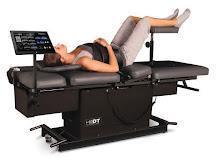The Benefits of Non-Surgical Spinal Decompression Therapy

Dr. Perkins was born and raised in Cincinnati, Ohio. He completed his undergraduate studies at The Ohio State University where he received his pre-med Bachelor of Science in Exercise Physiology and Human Nutrition. Following his passion for helping people avoid unnecessary drugs and surgeries, he continued his education... more
Non-surgical spinal decompression therapy has gained recognition as a non-invasive and effective treatment option for individuals suffering from various spinal conditions. By utilizing advanced technology and gentle techniques, this therapy offers a range of benefits that can significantly improve the quality of life for patients. In this article, we will explore the advantages of non-surgical spinal decompression therapy and how it can positively impact individuals with spinal issues.
1. Non-Invasive and Safe:
One of the primary benefits of non-surgical spinal decompression therapy is its non-invasive nature. Unlike surgical interventions, which can be accompanied by risks and potential complications, non-surgical decompression therapy does not involve any incisions, anesthesia, or hospitalization. The treatment uses mechanical traction to gently stretch the spine, reducing pressure on the affected discs and nerves. This non-invasive approach makes it an attractive option for individuals seeking pain relief without the associated risks and downtime of surgery.
2. Effective Pain Relief:
Spinal decompression therapy has shown promising results in relieving chronic back and neck pain. By targeting the underlying cause of the pain, such as herniated discs, bulging discs, or degenerative disc disease, it helps to alleviate pressure on the spinal nerves. This reduction in pressure allows for improved circulation, nutrient exchange, and the retraction of herniated or bulging discs. As a result, patients often experience a significant reduction in pain, enabling them to regain mobility and engage in daily activities with greater ease.
3. Improved Function and Mobility:
Spinal conditions can severely limit an individual's ability to move comfortably and perform daily tasks. Non-surgical decompression therapy aims to restore functionality and mobility by addressing the root cause of the problem. As the therapy progresses, the decompression process promotes the regeneration of damaged discs and increases the space between vertebrae. This can lead to improved spinal alignment, enhanced joint mobility, and an overall increase in range of motion. Consequently, patients may experience reduced stiffness, increased flexibility, and an enhanced ability to engage in physical activities.
4. Minimizes Reliance on Medication:
Chronic spinal pain often leads to a heavy reliance on pain medication, which can have adverse side effects and limited long-term benefits. Non-surgical spinal decompression therapy offers an alternative approach that aims to reduce or eliminate the need for medication. By addressing the underlying cause of the pain, the therapy can help patients manage their condition more effectively, potentially reducing the frequency and dosage of pain medication. This aspect not only improves overall well-being but also minimizes the risk of dependency and associated side effects.
5. Customized Treatment and Minimal Downtime:
Non-surgical spinal decompression therapy can be tailored to meet the specific needs of each patient. The treatment can be adjusted based on the individual's condition, severity of symptoms, and progress throughout the therapy. Moreover, this therapy generally requires minimal downtime, allowing patients to continue their daily routines without significant interruption. The convenience and personalized nature of non-surgical decompression therapy contribute to its appeal as a viable treatment option.
Non-surgical spinal decompression therapy offers numerous benefits for individuals suffering from spinal conditions. Its non-invasive nature, effectiveness in pain relief, improvement in function and mobility, reduced reliance on medication, and customized treatment approach make it a compelling alternative to surgical interventions. As healthcare continues to advance, non-surgical spinal decompression therapy holds great promise in enhancing the well-being and quality of life for those dealing with spinal issues.








